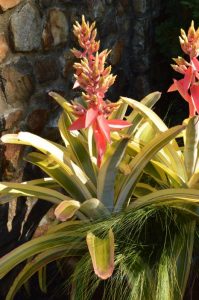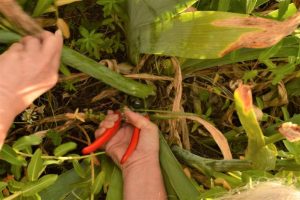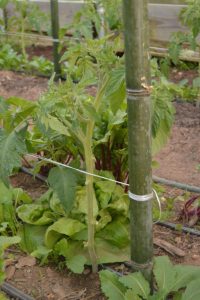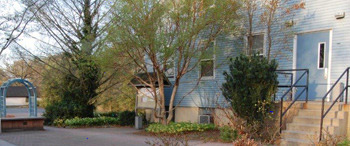Summer has arrived! The days are wonderfully long, rain has proven to be ample to S date, and the temperatures promise to become more summer-like as the month progresses. June is filled with chores that linger from spring, as well as preparations necessary for the garden to continue to thrive well into late fall. As the temperatures rise, enjoy the coolness of the early morning and evenings for those tasks requiring the most exertion, with the heat of the day reserved for light duties. Try to water in the early morning as well, since evening watering tends to promote diseases and evaporation is most extreme during the mid-day hours. Also, don’t forget your hat and sunscreen. Finally, remember to sit down with your favorite cold beverage to write in your journal and to enjoy the fruits of your efforts!
Things to do:
Flowers
- Finish decorating containers and mixed borders with annuals and tropicals. The rather chilly weather of May has pushed back much of the planting of tender plants to this month. Do not be bashful about using larger and bolder plants such as Banana, Canna, Alocasia, Colocasia or even some of the larger Bromeliads such as Aechmea ‘Harvey’s Pride’ as pictured at right. The bolder foliage adds a wonderful textural impact as well as foliage color.
- Fertilize annuals with a liquid feed once per week through June to give them a good start. If you used slow release fertilizer in your containers, use a 50% dilute solution of liquid feed. During hot periods, containers may need to be watered twice per day, especially if they are in the sun and the pots are smaller than 12”.
- If you have deer, apply a deer spray weekly or after a heavy rain. It is best to rotate weekly between three different types of sprays for best effects.
- Deadhead May blooming Iris to reduce the occurrence of the Iris borer as pictured at right. Cut the flower stalks as close to the rhizome as possible. Study the blooms of your Iris; if the blooms are few and the foliage is limp or overly dense, the plant either needs division or to be moved to a more sunny location. If it needs division, August is the best time.
- Weed! All of the rain and cool weather from May has created abundant growth and the spring blooming weeds are about to go to seed. Remember, weed seeds last an average of 7 years! Also, do not be afraid or feel bad about removing seedlings of the more aggressive perennials. Brunnera macrophylla is a beautiful spring blooming plant, but can monopolize a garden!
- Deadhead the Peonies as they finish blooming.
- Lightly fertilize repeat blooming daylilies and Roses at the end of the month for a good August/September bloom.
- Resist the urge to remove the yellowing foliage of Daffodils and other bulbs until it has totally turned brown. The foliage is producing the carbohydrates and storing them to ensure a good floral display for next year.
- Plant native plants! Help feed out butterflies, moths, native bees and caterpillars. We need our insects to thrive so that we can too!


Shrubs and Trees
- For small trees and shade trees, pinch off most of the water sprouts that you see growing from branches or stems – typically they appear at points where water sprouts or a branch was pruned off this past winter! Removing them as they start to grow discourages future dormant bud break.
- Many low branched trees may need to have portions of the lowest branches removed, as the new growth from May and early June adds weight to the branch, causing it to droop ever lower. This is a chore that often needs to be done each year until the tree is at least 15-20 years of age and the stems are of significant size to support the added weight.
- Selectively prune 2-3 stems of leggy multi-stemmed shrubs such as Fothergilla that may be growing in too much shade back to 6-8” tall too promote new growth from the base. Early June is also a great time to prune Azaleas and Rhododendrons as they finish blooming, since it will not impact next year’s bloom!
Turf
- Cut turf weekly. During periods of drought, irrigate the turf for extended periods in the early morning, promoting deep root growth. As the summer heat begins, raise the cutting height to 3” to reduce the stress on the turf.
Vegetables
- Harvest spinach, lettuce, radishes and arugula daily. As the days become hotter, the lettuce will become increasingly bitter and less tasty. These plants will also produce flowers or ‘bolt’, after which the foliage becomes extremely bitter, so it is important to harvest while the plants are smaller. Once the plants begin to bolt, remove them and plant summer squash, okra, cucumbers, pole beans, or other vegetables that will provide a yield in 65-70 days (September into October).
- Early June is time to thin your beets to 3” apart should you wish to harvest baby beets or 5-6” should you wish them to grow larger. Either pull out or cut off the Harvest spinach, lettuce, radishes and arugula daily. As the days become hotter, the lettuce will become increasingly bitter and less tasty. These plants will also produce flowers or ‘bolt’, after which the foliage becomes extremely bitter, so it is important to harvest while the plants are smaller. Once the plants begin to bolt, remove them and plant summer squash, okra, cucumbers, pole beans, or other vegetables that will provide a yield in 65-70 days (September into October).
- Early June is time to thin your beets to 3” apart should you wish to harvest baby beets or 5-6” should you wish them to grow larger. Either pull out or cut off the baby foliage, should you not wish to disturb the soil. Don’t throw away the leaves either, since they are a great addition to salads!
- It is not too late to plant tomatoes. Planting in June often avoids the problems with early blight as well! If the plants are leggy, bury the stem up to the first true leaf, as the stem will produce roots and yield a sturdier plant. As the tomatoes grow, make certain that they are staked, lifting the fruit to come off the ground and reducing the chance of decay.
- For tomatoes, it is ideal to pinch off the lower shoots up to the point of the first flower cluster (pictured at right). This will allow for a more manageable plant and a more sustainable crop of fruit.
- Plant Eggplant, Peppers, Okra, Basil and other plants that prefer heat of summer early in the month.
- Mulch vegetables with newsprint or cardboard covered with straw, reducing weeds and water loss. This is ideal for Heirloom tomatoes since they need consistent soil moisture in order to discourage splitting of the fruit. You can also mulch with lawn clippings provided that herbicides or insecticides were not applied to the turf.
- Stop harvesting asparagus and rhubarb. They need to produce stalks and leaves of sufficient size in order to develop the energy reserves for next year’s harvest (the same reason that you do not remove bulb foliage until it has turned totally brown).
- Compost! If you have yet to set up a composting bin, this is a good time to start. Not only can most weeds (without seeds) go into the bin, but so can bolted lettuce plants and greens left from the dinner table. It is a great way to do our part to help reduce landfill waste.

Bruce Crawford
State Program Leader in Home and Public Horticulture, NJAES



